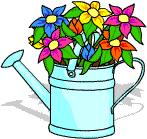The Cranky Gardener
Created | Updated Apr 17, 2004

Dog Days in the Garden
August! It's enough to make any gardener cranky. In my part of the world, (USA, Zone 6), it's hot enough to fry an egg on the pavement and dry enough to turn normally bubbling brooks into dry creek beds. And once again - I'm never going to learn - I have more planted than I have the energy to maintain.
It happens every year. In the spring, when the weather is wonderful and my brain is still filled with all those retouched images of perfect vegetables and flowers that make seed catalogs so irresistible, I order enough plants and seed packets for a garden twice the size of mine.
I spade. I till. I plant. I water. I weed. I feed. And everything is beautiful and lush and makes me happy to be alive. Then, suddenly without warning, August arrives and I swear that this is absolutely the last time I'm ever going to plant anything!
It's hot, the humidity is outrageous - high enough to make working outside miserable - and we haven't had a significant rainfall for over a month. My flower beds are drooping, my vegetable beds, berry and grape vines, and fruit trees are only hanging in there because I put five dollars worth of water on them every other day, and my lawn is drying up. Right now I'm hoping the lawn dies, so I won't have to mow it again.
The bush beans in the garden have finished. It's time to pull them up, enrich that bed and set out cole crops for fall use. Broccoli, cauliflower, Brussels sprouts, cabbage, kale. These vegetables all grow better in my climate in the fall than they do in the spring. Probably because our springs are short lived and summer comes too quickly. But they need to be set out in August. And who has the energy?
Another problem with this plan is the unfortunate lack of available plants in the garden centers. Ask the master gardeners in my area if fall gardens are a good idea, and they will tell you that they are. So why won't the garden centers order cool weather plants to be set out in the summer? You have to have enough foresight to start your own plants from seed or to take a chance on direct sowing the seeds into the garden. The problem with the later is that usually the bed I want to use for fall vegetables still has something growing in it when the seeds would need to be sown.
This year I started Green Goliath broccoli, Red Russian kale, and First White Hybrid cauliflower in Jiffy 7 peat pellets the beginning of July. They will be ready to transplant in another week. So my timing was good. But I would much rather have the option of buying plants at the garden center.
My cucumbers are giving out. In another week I'll be able to pull them out, enrich the soil, and plant snow peas to be harvested this fall. It's also time to plant spinach, carrots, onion sets and turnips for fall harvest. It's too early to plant lettuce and radishes. They'll be seeded in early September for harvest in October.
There is still an abundance of tomatoes and peppers in my garden. I've used them raw, cooked, given them away and still have more than I can use. For years I canned tomatoes in quart jars for use during the winter. This summer I haven't had the time. I didn't have time last summer either, so came up with this easier method of preserving my tomatoes. One good thing about this recipe is that you can adapt it to use a few tomatoes or a lot and the finished product can be used in soups and stews, Swiss steak, as a base for pasta sauce, pizza sauce or to season chili.
And before you ask - no, I don't scald and peel the tomatoes first. (Been there, done that, don't have time.) Those peels have loads of vitamins and fiber. They're good for you!
Hypatia's Stewed Tomatoes
You'll need an enamel or stainless steel stew pot, plain salt (not iodized), a wide-mouthed funnel, a ladle and heavy-duty quart freezer bags.
Ingredients:
- 1 gallon of fresh tomatoes, quartered
- 4 ribs celery with leaves, diced
- 2 large bell peppers, diced
- 2 large yellow onions, diced
- 2 6oz cans of tomato paste
- 1 head garlic, peeled and mashed
- 2 - 4 tspn salt, depending upon taste
Place all ingredients into the stew pot and bring to the boil. Do not add any water. Turn down heat and simmer until the tomatoes are cooked and the mixture is about the consistency of tomato sauce. Cool and ladle into freezer bags.
Is that easy or what? You can add fresh herbs when you actually use the tomatoes for what ever flavour you desire. If you add them now the flavours will fade, and you'll have to add them later anyway.
That's all for now. Keep gardening... even if it makes you cranky.
